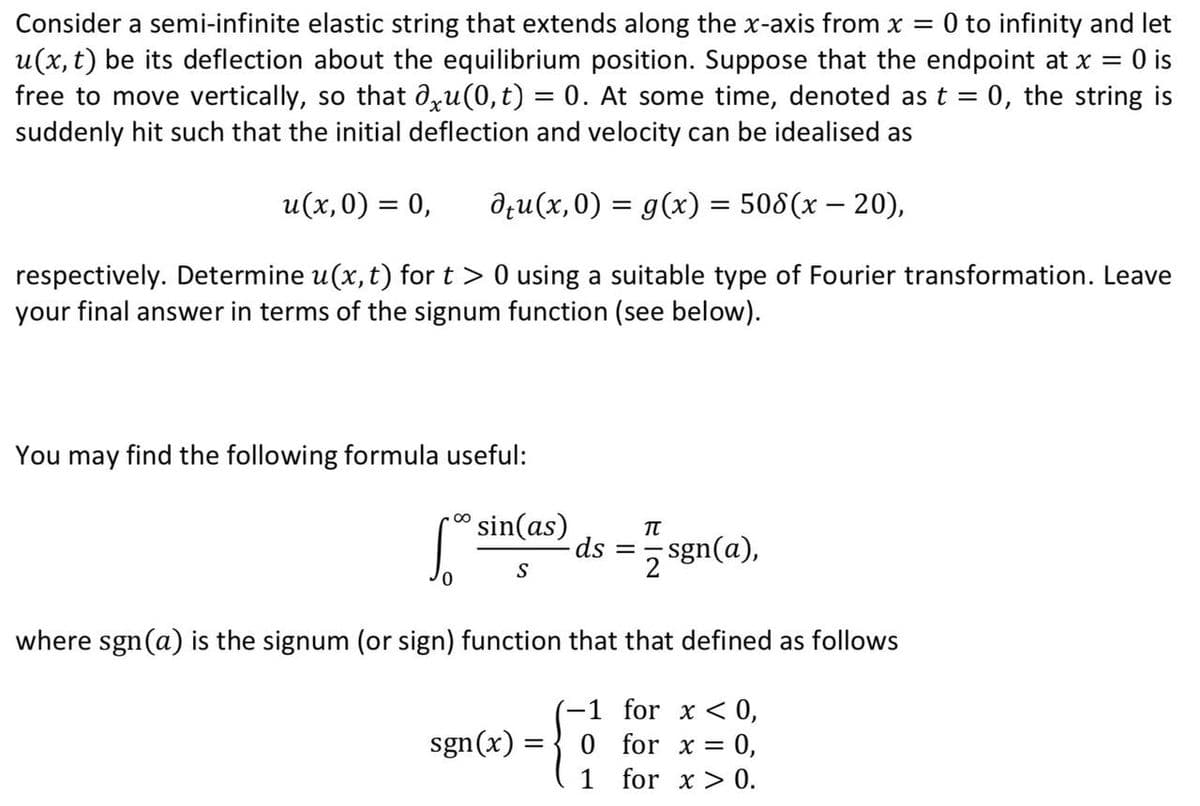Consider a semi-infinite elastic string that extends along the x-axis from x = 0 to infinity and let u(x, t) be its deflection about the equilibrium position. Suppose that the endpoint at x = 0 is free to move vertically, so that axu (0, t) = 0. At some time, denoted as t = 0, the string is suddenly hit such that the initial deflection and velocity can be idealised as u(x,0) = 0, du(x,0) = g(x) = 508(x - 20), respectively. Determine u(x, t) for t> 0 using a suitable type of Fourier transformation. Leave your final answer in terms of the signum function (see below).
Consider a semi-infinite elastic string that extends along the x-axis from x = 0 to infinity and let u(x, t) be its deflection about the equilibrium position. Suppose that the endpoint at x = 0 is free to move vertically, so that axu (0, t) = 0. At some time, denoted as t = 0, the string is suddenly hit such that the initial deflection and velocity can be idealised as u(x,0) = 0, du(x,0) = g(x) = 508(x - 20), respectively. Determine u(x, t) for t> 0 using a suitable type of Fourier transformation. Leave your final answer in terms of the signum function (see below).
Advanced Engineering Mathematics
10th Edition
ISBN:9780470458365
Author:Erwin Kreyszig
Publisher:Erwin Kreyszig
Chapter2: Second-order Linear Odes
Section: Chapter Questions
Problem 1RQ
Related questions
Question
Write clearly how to express final answer in terms of signum function.

Transcribed Image Text:Consider a semi-infinite elastic string that extends along the x-axis from x = 0 to infinity and let
u(x, t) be its deflection about the equilibrium position. Suppose that the endpoint at x = 0 is
free to move vertically, so that axu(0,t) = 0. At some time, denoted as t = 0, the string is
suddenly hit such that the initial deflection and velocity can be idealised as
u(x,0) = 0,
respectively. Determine u(x, t) for t > 0 using a suitable type of Fourier transformation. Leave
your final answer in terms of the signum function (see below).
du(x,0) = g(x) = 508(x − 20),
-
You may find the following formula useful:
S
sin(as)
S
sgn(x) =
ds
=
=
TT
where sgn(a) is the signum (or sign) function that that defined as follows
-1 for x < 0,
0
for x = 0,
1
for x > 0.
sgn(a),
Expert Solution
This question has been solved!
Explore an expertly crafted, step-by-step solution for a thorough understanding of key concepts.
This is a popular solution!
Trending now
This is a popular solution!
Step by step
Solved in 3 steps with 3 images

Recommended textbooks for you

Advanced Engineering Mathematics
Advanced Math
ISBN:
9780470458365
Author:
Erwin Kreyszig
Publisher:
Wiley, John & Sons, Incorporated

Numerical Methods for Engineers
Advanced Math
ISBN:
9780073397924
Author:
Steven C. Chapra Dr., Raymond P. Canale
Publisher:
McGraw-Hill Education

Introductory Mathematics for Engineering Applicat…
Advanced Math
ISBN:
9781118141809
Author:
Nathan Klingbeil
Publisher:
WILEY

Advanced Engineering Mathematics
Advanced Math
ISBN:
9780470458365
Author:
Erwin Kreyszig
Publisher:
Wiley, John & Sons, Incorporated

Numerical Methods for Engineers
Advanced Math
ISBN:
9780073397924
Author:
Steven C. Chapra Dr., Raymond P. Canale
Publisher:
McGraw-Hill Education

Introductory Mathematics for Engineering Applicat…
Advanced Math
ISBN:
9781118141809
Author:
Nathan Klingbeil
Publisher:
WILEY

Mathematics For Machine Technology
Advanced Math
ISBN:
9781337798310
Author:
Peterson, John.
Publisher:
Cengage Learning,

